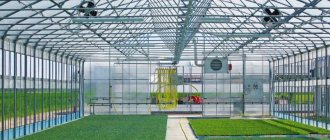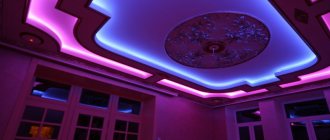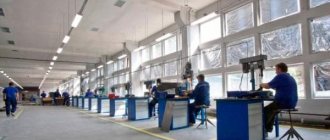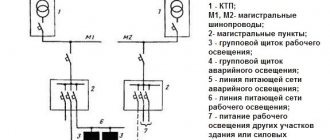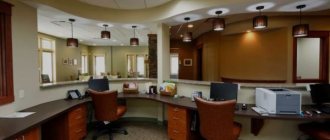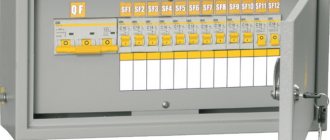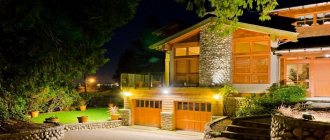04/18/201606/26/2016 master
In any type of production, lighting plays a special role in organizing the work process. It must be remembered that there are specially developed and established standards for light levels, depending on the type of room and its operational purpose. These standards are prescribed for any type of lighting that is used in production and public buildings in the modern world.
This article will focus on the duty type of lighting in production.
Features of the room
Light at industrial facilities or public buildings operating around the clock plays an important role not only for the high-quality production of any product, but also for maintaining people’s performance at an acceptable level. Lighting standards developed for these purposes presuppose the safe activities of workers during day and night shifts.
Note! The standards specified in SNiP regarding the level of illumination for each specific case are the cornerstones of the correct organization of the labor process, as well as labor protection.
Artificial light in production
A lamp installed in a production room must meet the following requirements:
- provide even and sufficient lighting (standards for each room are prescribed in SNiP);
- functionality. Emergency or emergency lighting will have different implementations through lighting fixtures;
- providing conditions for an optimal work process;
- reducing visual fatigue of people during important production processes, as well as reducing the number of potential situations that could lead to injury or death.
All these requirements apply to absolutely all types of lighting, and they must be taken into account at the design stage of industrial facilities. Today, for industrial premises and public buildings (schools, hospitals, etc.), in addition to the two main types of lighting (artificial and natural), there are additional lighting options:
- working;
- emergency;
- duty;
- security.
Emergency lighting, like all other types, refers to the artificial type of space illumination. Let's take a closer look at what it is.
In medical premises
By all means, at least one lamp that is connected to the emergency lighting network must be located in rooms for emergency procedures, as well as in rooms of group 1. This is a classification of medical rooms according to state standards. In rooms of group 2 - 50% of the lamps must be connected to the emergency lighting network. In such rooms, it is also necessary to provide the ability to switch to emergency power supply for all equipment necessary for medical purposes.
Need to know
Emergency lighting
Emergency lighting is one of the types of artificial lighting of premises used at night. If there is such a need, a lamp that performs another function can also be used as emergency lighting. The standards and the characteristics of the luminous flux that the lamp must emit are identical for work, emergency and/or evacuation types of room lighting, as well as safety lighting.
The switching on of emergency lights in production and public buildings occurs exclusively during non-working hours, when the main shifts have finished their work, and a small number of employees remain at the production itself. A lamp (for example, ds-19) for such illumination is installed in those places where there is a need for constant presence of maintenance personnel. Its installation is required in:
- technological and warehouse premises;
- utility rooms;
- repair areas.
Note! To optimize the lighting process, a standby type lamp will almost always be equipped with a motion sensor. Installing such a sensor will improve energy efficiency by operating the lighting fixture only when necessary.
SNiP indicates that the standards for lighting that operates in standby mode will be approximately 10-15% of the nominal level. In some situations, a lamp operating in this order will be able to return to normal mode. Such a transition is possible when vehicles or people appear near the lighting fixture.
Emergency lighting
Definition of emergency lighting
Emergency lighting
- lighting intended for use outside of working hours. It is used for more effective protection of premises, buildings and structures in the dark, to ensure safety at the site. The decisions made during the design work, when constructing and calculating emergency lighting, make it possible to achieve an optimal level of illumination, sufficient to orient people in a dark room.
Areas of application
Emergency lighting is used at various facilities, with different areas of enterprise activity, for example:
· administrative buildings
· educational establishments
· offices
industrial enterprises
· medical organizations
· production premises of railway transport facilities
· shopping centers and halls
· warehouses
· lighting of passenger cabins and cabins of airplanes, trains and subways, powered by batteries
Today, the use of light sources with emergency lighting function in apartments and cottages has become relevant. This is due to the development trend of lighting products in this direction.
Requirements for emergency lighting
Unlike working and emergency lighting, emergency lighting is not subject to special standardized requirements for lighting quality, illumination value and uniformity. Regulatory documents allow the use of some working or emergency lighting fixtures when designing emergency lighting. It is provided in places where the presence of people is possible or necessary. Lighting control, as a rule, is carried out automatically, remotely from posts or devices installed at the entrance to the room. An undeniable advantage of emergency lighting is energy savings. Considering that large-scale objects are provided with lighting, such savings will be quite noticeable.
IMPORTANT!
Emergency lighting lamps are positioned in such a way as to indicate the location of obstacles during movement and promptly detect objects and foreign objects along the route that may pose a danger due to insufficient visibility.
Due to the rapid pace of development and introduction of new technologies, there is a gradual replacement of lamps for emergency lighting, where incandescent lamps or fluorescent lamps are used as a light source, with lamps with more economical LEDs. The use of LED lamps allows you to achieve a good level of illumination with natural color rendering with more compact dimensions of the housing structure. This ensures an acceptable level of illumination in the premises.
Construction of an emergency lighting system
Due to the lack of standardized illumination values for emergency lighting, as a rule, 10-15% of the nominal level of working lighting is provided. The luminaires are powered from an independent group line. At the end of working hours, some of the working lighting fixtures remain in standby mode when turned off.
1. For emergency lighting at an enterprise
, for the purpose of visual control when walking around the building, illumination of 15-25 lux will be sufficient.
2. Emergency lighting of medical institutions
organized at the entrances to the ward, installing lamps intended for medical premises at a height of 300 mm from the floor.
3. For wards of children's departments
the standardized installation height of emergency lighting lamps above the doorway is at least 2200 mm from the floor. The connection is made to the emergency lighting network. Switching on in the wards is carried out according to a schedule, while patients are sleeping, thanks to this the light becomes dim, not interfering with sleep, and at the same time a minimum level of illumination is ensured.
4. Emergency lighting fixtures in corridors and hallways
, allow you to move around the apartment without using working lighting. For these purposes, lamps with built-in or remote light and motion sensors or low-power lamps, so-called night lights, are used.
5. For safe ascent and descent of stairs
use special lamps installed in the steps.
IMPORTANT!
Emergency lighting in private houses and apartments has a deterrent effect to prevent attempts by unauthorized persons to enter, since it creates the effect of the presence of people in the room.
Entrust the calculations to professionals!
Emergency lighting must be designed in accordance with the wishes of the Customer and the requirements of regulatory documents, the lamps are correctly selected and distributed in accordance with their type and location. With a professional approach, emergency lighting will work as efficiently as possible.
Our organization offers services for the design of energy-efficient lighting systems based on LED light sources. The organization is a member of the self-regulatory organization “Association of Designers “Architectural Solutions”
. Registration number of a member of a self-regulatory organization and the date of its registration in the register of members of a self-regulatory organization: No. 256 of 03/11/2020.
We will be glad to see you among our Customers!
Features of the mode
Working device
Emergency lighting for different rooms may have different features. For example, if we take into account the standby light mode in hospitals, then it is equivalent to an evacuation mode. According to current standards, a duty lamp (ds-19) must be installed at a height from the floor level of approximately 30 cm.
Activation of such a lighting device occurs only after lights out. The light coming from it is soft and muted. It is enough to provide a minimum level of illumination in hospital corridors. This is done so that the light from such lamps does not interfere with the restful sleep of patients, but allows, if necessary, medical staff to move freely and quickly along the corridors. But for medical and preventive premises intended to accommodate children of different age groups, the lamp (for example, type ds-19) should be installed at a height of at least 2.2 meters above
floor level.
Emergency lamp for the doorway
Note! Such requirements also apply to psychiatric hospitals.
Here, the optimal location for the lighting fixture is the doorway.
For rooms where very young children stay, it is recommended to place emergency lamps (type ds-19) at a height of 0.3 m from the floor level. But here it is necessary to remember that the voltage in the network should not be higher than 42 V. And such features exist in almost every place where an emergency lighting device should be installed.
Emergency lighting requirements
p, blockquote 2,0,0,0,0 —>
Emergency lighting standards require emergency lighting and evacuation lighting in crowded and hazardous areas
p, blockquote 3,0,0,0,0 —>
Which places and zones are regulated by standards are given in clause 7.62 of SNiP 23 – 05 – 95.
| № | Illuminated objects | Average illumination Ecp, lux not less | Illumination distribution Emin / Eсr not less |
| 1 | Evacuation routes for high-risk areas | 15 | 0,10 |
| 2 | Escape routes up to 2 m wide | 1 | 0,025 |
| 3 | Evacuation lighting for large areas | 0,5 | 0,025 |
p, blockquote 4,0,0,0,0 —>
| № | Illuminated objects | Average illumination Ecp, lux not less |
| 1 | Security lighting (in the absence of special technical means) | 0,5 |
p, blockquote 5,0,0,0,0 —>
Modern lighting design codes and regulations distinguish between emergency or emergency lighting and emergency lighting. Emergency lighting performs the functions of general lighting in the event of an emergency power outage to the main lighting network and ensures that work is carried out to restore the main lighting or other type of emergency. Power backup is made through the use of electric generators, which also supply electricity to the emergency lighting line. According to the rules, an illumination level of at least 10% of the main recommended working lighting for a given type of activity must be guaranteed.
Where is it used?
In addition to production facilities, emergency lamps are used in the following buildings and premises:
Emergency lamp
- administrative and public buildings;
- medical buildings;
- educational institutions (schools, kindergartens, universities and institutes);
- offices;
- premises of various shops, as well as shopping centers.
As you can see, the scope of application of this type of lighting is quite large. Therefore, lighting devices for creating such illumination during non-working hours are also very diverse, both externally and internally (meaning the use of various light sources). But the most common of them is the ds-19 lamp (usually the UHL4-1 brand).
Using such lighting has a number of advantages.
Benefits of use
The use of emergency lighting fixtures indoors, especially the ds-19 uhl4-1 type, will allow you to achieve many clear advantages:
Lamp ds-19 ukhl4-1
- significant savings in terms of energy consumption. Emergency lighting and luminous flux standards for it allow you to save about 2.5 times on electricity;
- there is no need to install additional equipment and provide unnecessary maintenance;
- there is no need for special disposal;
- the presence of a high color rendering index;
- absence of negative lighting visual effects. For example, pulsations of light flux. It is this effect that is considered the most harmful to the eyes, due to which there is a rapid decrease in visual acuity;
- the cost of such equipment is fully compensated by the quality of the lamp, as well as the level of luminous flux that it creates during its operation.
In addition, many lighting devices of this type have a long service life. For example, the ds-19 ukhl4-1 lamp can operate for over 50,000 hours. If LEDs are chosen as the light source, then special diode protection must be used. It guarantees uninterrupted operation of the lighting device, even if one of the LEDs burns out. The simple design of the lamps allows for quick installation on various surfaces, including hard-to-reach places.
Tips for organizing a meeting
Office lighting
Since the duty meeting is used not only in industrial buildings, but also in most public buildings, the choice of lamps is best made taking into account these simple recommendations:
- determination of lighting level standards for a specific room;
- the lighting device must fully meet the requirements of this type of room. So, for hospitals and offices these requirements will be diametrically different;
- the need for the lamp to have or not have moisture-proof properties, as well as a metal casing to protect against various types of mechanical damage.
It should be remembered that installation of such devices can be carried out both in special niches in the wall, and with the help of fasteners on the surface of the walls. Emergency lighting is an integral part of the lighting system in most public buildings and requires mandatory compliance with the relevant standards in its organization.
Requirements for security lighting
Not so long ago, security lighting performed only a visual, lighting function. Previously, a watchman or sentry used light sources to clearly see the protected area and illuminate the area. Now such lamps have a new, more complex purpose. Often lighting is installed in tandem with video cameras that broadcast recordings to guard monitors. Because of this development in technology, luminaires need to consider not only that they need to illuminate the area, but also that they need to tailor the lighting to the features of the CCTV camera being used. The direction of the light flow depends on the location of the security point. If the point is located inside the protected perimeter, then the light is directed beyond it. In this case, the guards remain undetected, while the entire surrounding area is illuminated and monitored. If the security point is located outside the territory that needs patrolling, the light is directed specifically at the protected object itself. The security space is brightly lit, and if an outsider tries to cross its boundaries without appropriate permission, the guards will notice the attempt to enter and prevent it. Regardless of the location of security points, a properly installed lighting system will detect a potential criminal from a distance of 200 meters and will not let him out of constant surveillance.
